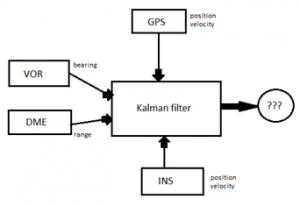This set of Avionics Interview Questions and Answers for freshers focuses on “Flight Management Systems – 2”.
1. Both FMS 1 & 2 get information from only one FMC in the case of ______
a) Independent mode
b) Loss of one FMC
c) Single mode
d) Double mode
View Answer
Explanation: In Single mode operating mode of the FMS two of the FMC is not in operation and this might cause one of the two FMS to fail. Hence both the FMS get information from one FMC.
2. The standby FMC performs calculations even when both the FMC are fully functional.
a) True
b) False
View Answer
Explanation: The standby computer does not perform any calculations, but is regularly updated by the master FMC. In the case of a single FMC failure, the standby FMC provides data to FMS connected with the failed FMC.
3. What filter is used by the FMS to estimate the position of the aircraft from various sensors?
a) Kalman filter
b) Position error filter
c) GPS filter
d) Gyro and accelerometer filter
View Answer
Explanation: The FMS combines the data from the navigational sources, comprising the inertial systems, GPS and the radio navigation systems, in a Kalman filter to derive the best estimate of the aircraft position. Each navigation system has its own advantages and limits, a Kalman filter combines the resource from all the systems to provide a more accurate position of the aircraft.
4. What is the output for the following system?

a) Aircraft position
b) All the fight data
c) Gyro and accelerometer values
d) Warning signals for wrong navigation
View Answer
Explanation: The final output of a Kalman filter is the best estimated aircraft position derived from various radio and inertial/GPS sensors. The direct information from the sensors ( raw data) cannot be used directly for accurate position location as their error increases with time.
5. Which one of the following is not a navigation mode used by FMS for computing position of the aircraft?
a) Inertial (IRS) – GPS
b) Inertial (IRS) – DME/DME
c) Inertial (IRS) – VOR/DME
d) GPS only
View Answer
Explanation: Each FMS computes the aircraft position and the position accuracy. The FMS computed position is an optimum combination of the inertial position and the GPS or radio position, depending on which equipment provides the most accurate data. This results in four navigation modes: Inertial (IRS) – GPS, Inertial (IRS) – DME/DME, Inertial (IRS) – VOR/DME, Inertial (IRS) only. The only GPS is not used as the position information is within a radius where the aircraft is flying.
6. Navigational functions are no longer available if the INS shuts down in an FMS.
a) True
b) False
View Answer
Explanation: The FMS aircraft position always uses the inertial position. This computation is not possible if the inertial position is not valid, and in this case, all the FMS navigation and flight planning functions are no longer available. FBW system also fails in the case of an INS shut down since it uses INS for feedback.
7. What is the interval for updating data in the navigation database?
a) 1 hour
b) 1 month
c) 24 hours
d) 28 days
View Answer
Explanation: The navigation database is updated every 28 days, according to the ICAO AiRAC cycle, and is held in non-volatile memory. It is clearly essential to maintain the recency and quality of the database and the operator is responsible for the detail contents of the database which is to ARINC 424 format.
8. Which one of the following is not a factor for calculating speed breaches by the FMS?
a) Aircraft weight
b) CG position
c) Wind and temperature models
d) Position of the aircraft
View Answer
Explanation: The FMS continually monitors the aircraft envelope and ensures that the speed envelope restrictions are not breached. It also computes the optimum speeds for the various phases of the flight profile. This is carried out taking into account factors such as: Aircraft weight – computed from a knowledge of the take-off weight and the fuel consumed (measured by the engine flow meters), CG position – computed from known aircraft loading and fuel consumed, Flight level and flight plan constraints, Wind and temperature models, Company route cost index.
Sanfoundry Global Education & Learning Series – Avionics.
To practice all areas of Avionics for Interviews, here is complete set of 1000+ Multiple Choice Questions and Answers.
If you find a mistake in question / option / answer, kindly take a screenshot and email to [email protected]
- Practice Aeronautical Engineering MCQs
- Check Avionics Books
- Apply for Aerospace Engineering Internship
- Check Aeronautical Engineering Books
- Practice Aerospace Engineering MCQs
